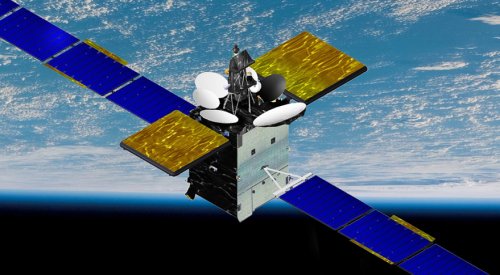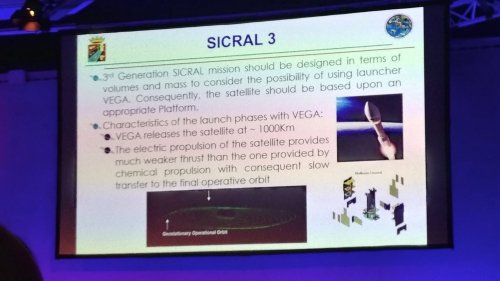LONDON — The Italian Ministry of Defense may use two satellites to replace a single existing satellite so that it can use the Italian-led Vega C or Vega E rocket, according to a defense official.
Lt. Col. Luigi Mauro, head of the Italian Ministry of Defence’s Satcom Systems Section, said the Italian government approved last year a replacement for Sicral 1B, a 3,000-kilogram military communications satellite that launched on a Sea Launch Zenit-3SL rocket to geostationary-transfer orbit in 2009.
Rather than grow in size as Italy did with the 4,400-kilogram Sicral 1B satellite that launched in 2015 on an Ariane 5 rocket, Mauro said the ministry is looking at ways to shrink down to two lighter satellites that would fit on a smaller Vega-series rocket.
If Italy takes this approach for the Sicral 1B replacement satellite, known as Sicral 3, “it will be that we will have to split the project into two satellites,” he said at the 2018 Global Milsatcom conference here.
The two satellites would have a mass between 2,000 and 2,300 kilograms, he said, though a final decision has not been made.
Mauro did not explain how such a mission would enable a satellite to reach geostationary orbit 36,000 kilometers above the Earth, since Vega C, which debuts next year, is optimized for up to 2,300 kilograms to low Earth orbit.
Vega C and Vega E are next-generation launchers under development by Avio of Colleferro, Italy. Vega E will not be ready until around 2024, which is the same year Italy wants to launch the Sicral 3 satellite or satellites, if not earlier, Mauro said.
Mauro said research and development work for Sicral 3 is ongoing. The satellite’s purpose is to continue services from Sicral 1B that are in ultra-high frequency, super-high frequency and Ka-band, with the Italian Navy driving demand for an increase in Ka-band, he said.
Italy has four military communications satellites in orbit: Sicral 1 and Sicral 1B, which are fully Italian, and Athena-Fidus and Sicral 2, which are joint satellites with France.
Mauro said Italy wants the Sicral3 program to deliver improvements over previous satellites in identifying ground-based interference, managing the distribution of capacity and to enable the use of smaller ultra-high frequency terminals.
- Military launch poised for new era as Air Force prepares to move beyond EELV
- Iridium to complete next-generation satellite deployment by this fall
- LEO and MEO broadband constellations mega source of consternation
- Avio expanding Vega launch abilities, mulls “light” mini-variant
- SpaceX takes top honors in SpaceNews Awards for Excellence & Innovation
Share with your friends


(0) Comments
This article comments are currently no :(